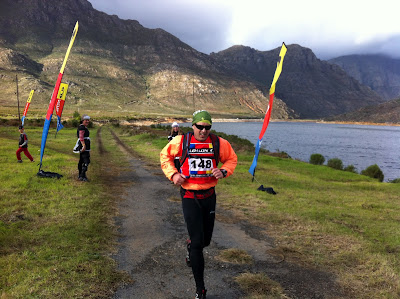The ankle joint is a
Synovial joint type. This is the most common and most moveable type of joint in the human body.
The joint is comprised of:
1. Bones and cartilage
2. Ligaments
3. Muscles and tendons
Bones & Cartilage
The important point to consider here is that the ankle is a complex joint - technically 2 joints.
The first joint, the '
True Ankle Joint or Talar Joint' allows you to bend the foot up (Dorsiflexion) and down (Plantar Flexion). Here the joint pivots around the Tibia, Fibia and upper Talus.
The second joint is the "
Subtalar Joint" which allows the foot to move or roll sideways. Either the foot moving inwards (Inversion) or out (Eversion). This joint pivots around the bottom side of the Talus (hence subtalar) and the Calcaneus or heel bone.
The True Ankle Joint is kept in place in a kind of 'mortise and tenon' configuration. With the Fibula providing stability on the outside (lateral side) and the hanmer of the Tibia the stability on the inside (medial side).
Cartilage covers all the sections on these joints where bone meets bone and, along with the joint capsule (a water filled like sack), allows for smooth gliding of the joint.
With respect to the bone structure of the joint there are two important points that impact on the effective functioning:
1. Range of motion
The ankle has a limited range of motion in which it can effectively funciton while maintaing the integrity and stability of the joint. This is measured in degrees and is typically in the region of:
- Ankle plantar flexion (movement downward) 0-50
- Ankle dorsiflexion (movement upward) 0-20
- Ankle inversion (turned inward) 0-35
- Ankle eversion (turned outward) 0-25
2. Destabilization
The closer you get to the maximum degree of the flexibility the more unstable the joint will become. It is said that the ankle in full plantar flexion is very unstable.
Ligaments
The ankle joints are kept in place by ligaments. There are fibrous tissues made from bundles of collagen fibers that connect bone to bone and are very different in form and function to tendons which connect the muscle to the bone.
Initially thought to be very basic structures, they have now been shown to perform their function with surprising complexity.
The ligaments in the ankle (or any other joint for that matter) provide three functions:
- Mechanical strength. They passively align the joint to function within its normal range of motion and thus stabalise the joint.
- The viscoelastic nature of ligaments help with returning the ankle to its rest position after it has been used
- Finally, ligaments provide proprioceptive information. This information helps the brain to determine where you foot is in space
There are two sets of ligaments:
A. Lateral Collateral Ligaments
These are the ligaments on the outside of your foot, furthest from your other ankle. The lateral collateral ligament prevents excessive inversion. It is considerably weaker than the larger medial ligament and thus sprains to the lateral ligament are much more common, especially in trail running. It was these ligaments that i damaged. It is made up of 3 individual bands:
Anterior talofibular ligament (
AFTL): passes from the fibula to the front of the talus bone.
Calcaneofibular ligament (
CFL)- connects the calcaneus and the fibula
Posterior talofibular Ligament (
PTFL)- passes from the back of the fibula to the rear surface of the calcaneus.
B. Medial Collateral Ligaments
The medial ligament also known as the deltoid ligament is considerably thicker than the lateral ligament and spreads out in a fan shape to cover the distal (bottom) end of the tibia and the inner surfaces of the talus, navicular, and calcaneus.
Muscles & Tendons
Most of the motion of the ankle is caused by the stronger muscles in the
lower leg whose tendons pass by the ankle and connect in the foot.
Contraction of the muscles in the leg is the main way that we move our
ankle when we walk, run, and jump.
The muscles and associated tendons and their functions are:.
- The peroneals (peroneus longus and peroneus brevis) on the outside edge of the ankle and foot bend the ankle down and out.
- The calf muscles (gastrocnemius and soleus) connect to the calcaneus by the Achilles tendon. When the calf muscles tighten, they bend the ankle down.
- The posterior tibialis muscle supports the arch and helps turn the foot inward.
- The anterior tibialis pulls the ankle upward.
Now that we understand the structure of the ankle, in my next posts I want to take a look at:
Ankle 3: Injuries and treatment
Ankle 4: Preventative measures
References & Copyright
This information provided in this post is not meant for professional diagnostic purposes. However, I believe that an informed trail runner is a better trail runner. So the information here is to help you understand what is happening inside your body as you run. I hope you find it useful.
Although I referenced a number of websites, the text above is mostly my own. I claim no right to the images above and their copyright remains with the original party. The images are URL references to the original site. The site that I found the most useful, and from which I link to most of the images is:
Advanced Sports Therapy
Other sites referenced are:
Dartmouth Medical School
Wikipedia of course
Excellent article on ligaments at International Society of Musculoskeletal and Neuronal Interactions (ISMNI)
About.com


















